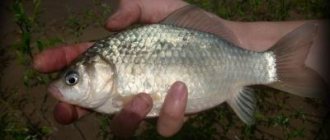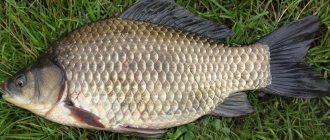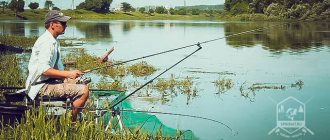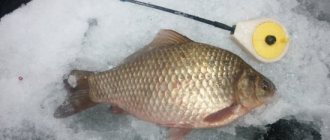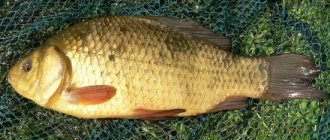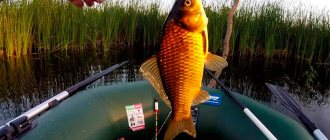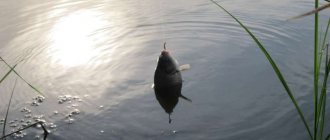Unlike a number of other representatives of the carp family - roach, bream, chub, crucian carp is more thermophilic. You should not expect results from catching this fish in early spring, as soon as the ice melts on the reservoirs. On average, it takes 2-3 weeks for crucian carp to become active after the water surface is freed from the ice cover - provided that the water temperature rises steadily.
Uncover your fishing rods when the water warms up to at least +6-7°C, and the crucian carp begins to gradually restore its vitality. In the southern regions, the water temperature reaches this mark in early April, and in the middle zone usually not earlier than the second or third decade.
Where to look for crucian carp in spring
In spring, crucian carp moves to shallow water, which is warmed up more quickly by the sun's rays. It is precisely such zones that should be of interest to an angler counting on crucian carp bites. Let's assume that if the depth in the pond does not exceed one and a half meters, then the most promising areas for fishing in the spring will be areas with a depth of 50-80 centimeters, where the fish are comfortable due to the higher temperature.
When looking for crucian carp, pay attention to the following places:
- Shallow bays , overgrown with water lilies, pondweeds and other aquatic vegetation by June-July, are favorite areas for crucian fish during summer fishing. Among the decaying plants of last year, crucian carp will always find food, so in the spring you can get biting at catchable points during the summer.
- The coastal zone near the walls of reeds and reeds is attractive to fish due to the abundance of food and favorable temperature conditions.
- Silted reaches with snags sticking out of the water . Korchi is a habitual habitat for crucian carp; in winter there is more oxygen penetrating through the cavities between the ice and snags. Accordingly, the snag breaks free of ice earlier and warms up faster. The silt deposits contain a wide variety of larvae that are consumed by fish.
- Floating peat islands . On hot May days, fish can hide under them from the scorching rays of the sun.
- Reclamation canals and filled clearings of peat quarries. In the spring, crucian carp emerge from the main swamp to the warm water of the canals, where they often remain to spawn. After spawning it falls back into the quarry.
- Streams and rivulets flowing into or flowing out of a body of water . Be sure to check for spills on the creek left after the flood.
How crucian carp behave in spring
The peak of the spring bite for crucian carp occurs in the pre-spawning period, when the water warms up to 15°C.
Precisely when the crucian carp is hungry and not so spoiled in choosing bait. He loses caution and begins to actively eat, restoring strength after hibernation. Crucian carp leaves deep places and moves to shallower and open areas of the reservoir, where it swims out to feed and soak in the warmed water. When moving, crucian carp actively digs in the silt and therefore its presence is not difficult to notice by swaying vegetation and cloudy water, as well as emerging bubbles. Thus, it intensively searches for food in coastal areas with a silted bottom and the remains of last year’s vegetation. In May, crucian carp most often choose places overgrown with reeds and other aquatic vegetation, exits from narrow bays or areas near snags and branches. Crucian carp feeds mainly in the morning and evening, and at noon this fish prefers sunbathing. When the sun sets, fish activity stops completely, so in the spring night fishing in cold water does not bring good luck.
Crucian carp spawning
The first sign of the beginning of spawning is large schools of fish, keen on mating games in the coastal strip of the reservoir. The onset of the spawning period does not have an exact date and therefore the start date of spawning varies and largely depends on the following factors:
- Water temperature . To start spawning of crucian carp, a certain water temperature is required, which should be at least 12 degrees. Only in the presence of favorable conditions can crucian carp go to spawn.
- Weather. An important factor influencing the spawning period is the atmospheric temperature. Warm and sunny weather promotes rapid spawning, which can pass in a couple of weeks, and in some cases even faster. Lower temperatures slow down the process, and spawning can last for a month.
- Location of the reservoir. Spawning of crucian carp in central Russia begins in mid-May. In the southern regions of the country, spawning occurs 7-10 days earlier, and in the northern regions, crucian carp spawn at the beginning, and sometimes in mid-June.
- Reservoir size. The duration of spawning of crucian carp is influenced by the size of the lake, stock, pond or river. The larger the body of water, the longer the reproduction process. Consequently, the period of spawning in small stagnant bodies of water occurs earlier and lasts much shorter.
Mating games for crucian carp begin much later than for other fish living in freshwater environments. For spawning, crucian carp choose secluded places at moderate depths. For some time the fish splashes, actively and noisily rubs, then in numerous groups it hides in the thick of the algae and sweeps up the reproductive products there. These phenomena are considered the main signal for fishermen, indicating the beginning of spawning and the complete cessation of biting.
When it starts to peck
An ideal place for catching crucian carp
Spawning occurs in May - June, depending on weather conditions, at a water temperature of 15 degrees. At this time, crucian carp gather in schools and spawn among aquatic plants. Spawning itself occurs quickly; in warm weather it ends within 2-3 days. Large individuals release eggs first, followed by small ones.
The bite in nature begins in early spring at shallow depths with plants, where the water warms up faster. After winter, it will be good to catch crucian carp until spawning, if the weather does not deteriorate.
During the spawning period, the biting stops and begins only after spawning. But there are days when crucian carp stops pecking for no apparent reason, even with various baits (bloodworms, worms, maggots).
The best bite is observed in those reservoirs where there are no other fish. From the end of summer and in the first half of autumn, there is sometimes not enough food in reservoirs, and then the bite becomes more stable. The most productive hours are from dawn to 10 am.
The evening bite begins an hour before sunset and stops with the onset of darkness. Crucian carp is a daytime fish and practically does not bite at night.
It bites poorly when there is complete calm; usually at such times it gathers in schools and frolics at the surface of the water.
We must remember that spring is different - the bite of crucian carp depends on the water temperature.
Types of float gear
- For catching crucian carp , a fly float rod is suitable , the length of which should be from 4 to 7 meters. Such rods are designed for catching fish near the coast, where it is possible to feed them. Fishing rods are made from durable and fairly lightweight materials. The gear can withstand good loads.
- A match rod for crucian carp should be from 3.6 to 4.5 meters long. Fishing rods have a fairly large number of throughput rings. More often, light rods are used - up to 10 g, sometimes heavy ones - up to 25 g. Such fishing rods are relevant when the fish goes to depth.
- Plug rods are used for fishing at very long distances. Their length can reach up to 14 meters depending on the number of tubes that are added or removed.
Float rod
The best tackle for catching spring crucian carp is a float rod, which has a number of advantages over bottom fishing methods:
- Crucian carp bite in the coastal zone in spring, so long-distance casting makes no sense. Throwing a feeder at your feet in conditions of high water transparency can scare away the fish. The float can be thrown without creating unnecessary noise;
- In the spring, the fish bite is not as dependent on bait as in the summer. The feeder creates a bait spot on the bottom, being tied to it during fishing. The floater is free to move around the reservoir in search of fish;
- With a float you can fish hard-to-reach places - cramps, clearings in the reeds, where no sane fisherman would throw a feeder.
There are several types of float rods: plug, Bolognese, match and fly. In summer, use any of them, depending on the conditions of the upcoming fishing.
In spring, plug and match rods are rarely used. Match fishing involves long casts of a heavy float. In the spring, sometimes crucian carp do not hold at distances of 30-40 meters. For fishing near the shore, standard match fishing rods 4-4.5 meters long will be a bit short.
with a plug on well-maintained canals or paid ponds with a flat coastline, which allows you to use such bulky gear. During spring fishing, in extreme conditions, a plug rod with its dimensions will prevent comfortable fishing.
In the spring, when fishing for crucian carp, use a Bologna and fly float from 5 to 7 meters long. The “lap dog” is equipped with rings and a reel with a supply of fishing line. By opening the spool of a spinning reel, you can make a cast that exceeds the length of the rod. Rewind if necessary. If a trophy fish is caught on the hook, we release the line from the reel to avoid breakage.
A fly fishing rod does not have the advantages of Bolognese tackle, nor its disadvantages. The fly rod does not have a reel, therefore it is lighter. The fishing line is equal to the length of the rod, to the connector at the tip of which it is attached. Due to the absence of rings on the “swing”, the line does not fray. Using a fly rod that does not have a supply of fishing line, forceful fishing is performed.
You can successfully catch crucian carp with either a fiberglass or carbon-carbon rod. If you are interested not only in the catch, but also in the feeling of comfort in the process, you should give preference to “charcoal”. Carbon fiber fishing rods are noticeably lighter than glass, and with active biting this property is irreplaceable.
To catch crucian carp, choose “noodle” rods. Thanks to their softness, they will absorb the jerks of large fish, which will protect the fishing line from breaking and the fishing rod from breaking.
Equipment options
Depending on the available elements of gear and the depth of the reservoir, equipment is selected:
Equipment using a locking unit
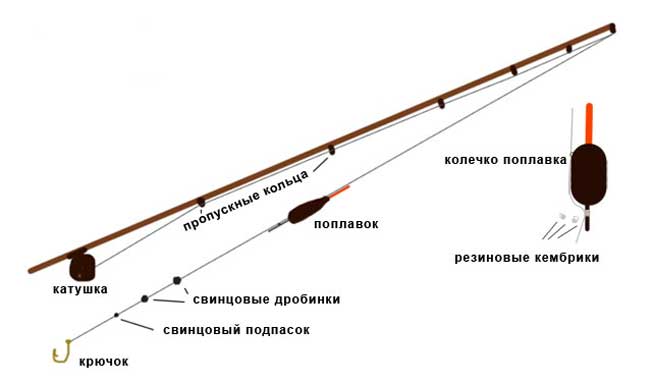
Another option for equipment with a reel
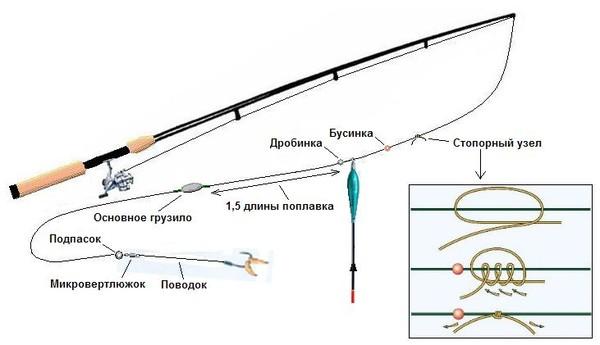
Equipment option with reel
Equipment elements
Fishing line . When fishing for crucian carp, it is not advisable to get carried away with fishing lines that are too thin. To avoid offensive encounters with a serious enemy, select a fishing line that matches the size of the intended prey. Monofilament with a diameter of 0.2 - 0.22 millimeters is used as the main fishing line for the lap-dog, and up to 0.25 for the fly rod. For leashes, use fishing line with a diameter of 0.14-0.18 millimeters. The length of the leash ranges from 10 to 25 centimeters.
An excellent material for knitting leashes is fluorocarbon. Fluorocarbon fishing lines are invisible in the water, resistant to abrasion and are good at absorbing fish jerks. The only disadvantage of fluorocarbon is a decrease in stability at the nodes. To reduce the likelihood of breakage, be sure to wet the knot when tightening.
Float . Crucian carp bites are cautious. This fish, having taken the bait, can hold it in its mouth for a long time without moving, so you need to select the most sensitive floats. Floats with a high antenna and a long keel, weighing from 1.5 to 2 grams, are used. The float is loaded so that only the antenna sticks out of the water. In windy weather, place an additional weight so that only the tip of the float is visible from the water. Otherwise you will miss the bite. We make floats with our own hands.
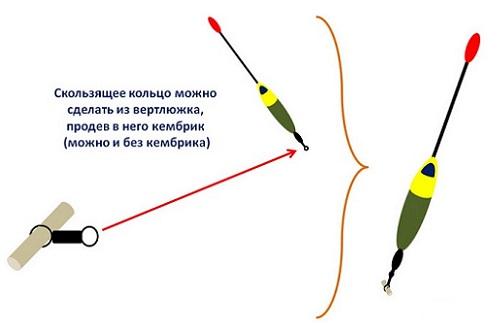
Sliding float equipment
Fishing of crucian carp often occurs in places with an abundance of hooks. In such a situation, the use of blind mounting of the float is problematic. A float floating in the water following a plunging bait can get caught on cramps or “burdocks” rising in May. The sliding rig allows you to throw the float straight to the fishing point. Such floats dangle freely on the fishing line, and when the hook with bait falls to the bottom, the float rises up the fishing line to the stopper. The stopper can be a silicone cambric or a special stop knot knitted from a thicker fishing line.
Sinker . The most popular among fishermen since Soviet times are pellet weights. The number of weights is selected according to the weight of the float and the desired degree of immersion. If two or more pellets are required, distribute them along the line so that the heaviest pellet is closest to the float. This will additionally provide the gear with high sensitivity.
Hook . For fishing, purchase hooks from 3 to 6 numbers according to the domestic classification, and from 8 to 16 according to the international classification. Naturally, the larger the crucian carp in a lake or pond, and in the spring it is easy to run into a solid specimen, the larger the hooks should be. With small hooks, gatherings of large fish are inevitable. The main thing is not to overdo it with the size, otherwise the fish will ignore even the most delicious bait, and you will find yourself without a catch.
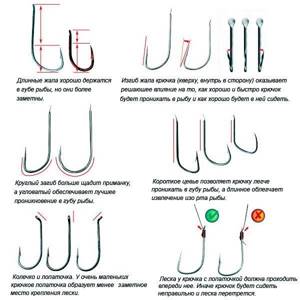
Baits, baits and lures
In spring, crucian carp prefers animal baits: bloodworms, maggots, earthworms or dungworms. But this fish can be successfully caught, especially in May, using plant baits. Bring semolina with you for spring fishing, from which you can make a mash right on the shore. The semolina mixture is screwed onto the hook using a syringe into which the shaken semolina is first pushed. Long loaf dough, black bread crumb flavored with honey or sunflower oil, steamed pearl barley will also not hurt.
Animal bait
- The mayfly is a unique butterfly that lives for one day and lays eggs on the stems of underwater plants and on rocks. Larvae hatch from these eggs, and they are the best bait for fish. Often this larva is also called “granny”;
- The caddisfly is also a butterfly that lays eggs in water. The larvae hatch, remain in the capsule for some time, then crawl onto the stems of aquatic plants;
- The worm is the most versatile bait. They can catch any fish. There are several types: dung worms, earthworms, earthworms (crawlers);
- Mormysh is a brown-green amphipod crustacean. It is usually found under the leaves of river plants;
- Bloodworm is a mosquito larva, a small dark red worm, found in the bottom silt. It is very delicate and preserving it can be a problem for the angler;
- May beetle (Khrushchev) is a good bait for fishing from the surface of the water, especially chub.
Chafer
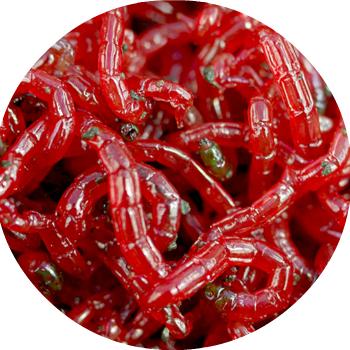
Bloodworm
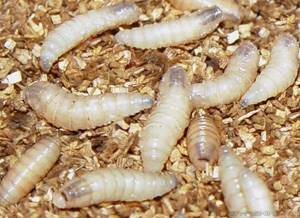
Plant baits
- Cereal grains – wheat, barley, rye. The grains are taken at the stage of waxy ripeness and simply placed on a hook, the ripe grains are ripped open;
- Porridges - use mainly cereal grains;
- Peas are the most delicious bait for fish. Each fisherman prepares this fish food using his own technology. You need to take brain peas (wrinkled);
- Dough – use any flour except pancake flour. Simply knead in a bowl, gradually adding water. You need to create such a consistency that it sticks to the hook. Flavorings are added to attract fish.
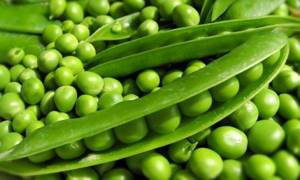
Canned or natural peas

Cereals are used both in the preparation of bait and as bait
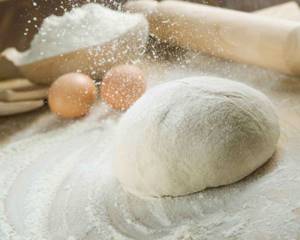
With the onset of spring, crucian carp begin to approach the shore for food, here the water is warmer. The main fishing tool for catching it is a float rod.
At this time, crucian carp bites on:
- bloodworm;
- dough;
- maggot;
- red worm.
Small individuals even peck on the crumb of white bread, or on flour dough. A worm and pearl barley sandwich might also be interesting.
Most ponds nowadays are terrorized by rotan, which rushes at every living thing that comes into its field of vision. Therefore, be sure to stock up on a wide variety of plant attachments - rotan is unlikely to be interested in them.
Features of catching crucian carp in the reeds
Surely you already know that crucian carp is usually found in thickets, in various ponds and reservoirs with dense vegetation. Therefore, to get a good catch you often need to find places with a lot of reeds or reeds. In addition, you will need to prepare the right gear and learn about all the nuances and features of such fishing.
It is worth knowing that crucian carp prefers areas with reeds, reeds, sedges and other vegetation for various reasons:
- firstly, in such places the fish have something to eat (a sufficient number of small crustaceans, various insects, flies, etc. live there);
- secondly, there is a more comfortable temperature regime for crucian carp;
- thirdly, this is an excellent place to hide from predators or lay eggs;
- fourthly, this representative of the aquatic environment loves to bury itself in silt, which is very abundant in places with abundant vegetation.
One of the most important steps is choosing the right place for fishing. You will need to find a “window” of water among the thickets and make your way there. We recommend that you familiarize yourself in more detail with the definition of the most successful location.
Choosing a place and time of fishing
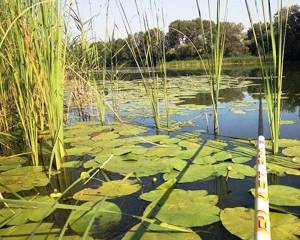
If you plan to fish in the spring, then you should know that at this time the crucian carp actually bites according to a schedule. So, in early spring you will find this resident of the reservoir almost at the very shore. At the same time, he will want to feast on it from 9-10 a.m. to 2-3 p.m. In the early morning, the bite will be very weak, since the water in the reservoir has not yet had time to warm up enough, and the fish will simply be passive. If you fish in late spring, then you should fish in deeper places; the crucian carp will gradually move away from the shore. The period of its active biting in this case falls at 7-12 o'clock in the afternoon. The rest of the time the bite will be quite weak, although exceptions are possible.
If severe frosts occur at night in the spring, then the crucian carp bite may stop altogether for several days, regardless of the time. Therefore, the optimal time would be the second half of spring and summer , when the water temperature is already quite high.
As for the fishing location, it can be either a deep-sea place or shallow water. The depth at which this representative of the aquatic environment lives can vary from 20 centimeters to two meters. The only favorable conditions are the optimal water temperature and the availability of food. If you plan to fish near the reeds in the spring, then most likely you will have to take special clothing with you, since traveling by boat is usually prohibited at this time.
How to select gear elements?
Another important step is the correct selection of gear that will be as strong and reliable as possible for fishing in such conditions. Since this type of fishing requires fairly accurate casts at various distances, it is worth using a regular float rod, the elements of which meet certain requirements:
- Rod . To effectively catch crucian carp in reed thickets, you need to use a short rod. If there is not a lot of tall and dense vegetation on the shore that could interfere with casting, then a rod length of up to 5 meters is acceptable. Otherwise, choose the shorter option. To completely eliminate any clinging to reeds, use a fly-type rod, the length of which is within 3-4 meters.
You don't need a reel, as it will only increase the risk of the line getting tangled and caught in vegetation. All equipment will be attached to the tip of the fishing rod using an ordinary connector.
- Fishing line . Both the main line (mono line works great) and the leader line (fluorocarbon) should have good strength to minimize the risk of breaking when snagging on plants. However, it is not recommended to use very thick ones, since the fish may notice that the equipment is too rough and get scared. The diameter of the main line can be approximately 0.2 mm, and the thickness of the leash is allowed within 0.16-0.18 millimeters. Use a darker colored line to make it as invisible as possible in the water.
- Hook with leash . It is advisable to use one leash with a hook. If there are a lot of them, the risk of them getting tangled in the grass or among themselves will increase. The shape and parameters of the hook are selected in accordance with the approximate dimensions of the fish and the type of bait used. The optimal hook class is 5-7.
- Float . For fishing in reeds, it is not advisable to use a float with an elongated top. Such an element can lead to tangling of the fishing line. A small float with a medium antenna and low weight is quite suitable. Its carrying capacity should not exceed 2 grams. Choose an element that, when dropped on the surface of the water, will not create unnecessary noise.
- Sinkers . Since such fishing is carried out in thickets without strong winds and currents, there is no need to make a good landing. Experts recommend making a very small load of the fishing rod so that it becomes more sensitive and is as invisible as possible to your potential prey. Choose a lead sinker that weighs half as much as the float.
As you can see, the process of selecting gear elements is not that complicated. All you need to remember is that you will be fishing in an area with a lot of vegetation, so the equipment should be selected taking into account these conditions.
Feeding should be done in advance (ideally one or two days before fishing). Any mixtures with cereals (including store-bought ones) are suitable for this. Boiled oat and corn grits have proven themselves well. As for bait, it is worth taking into account the preferences of crucian carp. Basically, it feeds on worms, small bugs, flies, etc., so any insects or various live baits are perfect as bait.
Bait for crucian carp
Groundbait and lures serve simultaneously to attract fish to one place and to accustom them to a specific bait. The food that is scattered during fishing is bait. And the one that is constantly scattered before fishing is a bait. We have a separate article on baiting for crucian carp.
On April days, feeding the fishing point is not necessary, but it will not be superfluous either. Small balls of earth mixed with breadcrumbs, small bloodworms or chopped worms are thrown into the water. Aromatization does not play a role in April.
In May, the increase in the activity of crucian carp is proportional to the increase in its capriciousness, so the use of bait becomes advisable. There are many domestic and imported bait mixtures that work quite well for this fish. However, you can also feed the fishing point with “homemade products” that have been proven over many years of experience.
A couple of recipes that perfectly attract crucian carp:
- For half a kilo of ground seeds with husks, add 200-300 grams of finely ground breading and 100-150 grams of semolina as a binding element. On the shore of the lake, pour water into the mixture in several stages. for 5-10 minutes to evenly distribute the liquid over all layers and go about other things. Then mix thoroughly so that there are no lumps left. If the complementary food is not too viscous, the balls form easily and do not fall apart at the slightest touch, then you did everything right. The result is a balanced feed containing small and large fractions.
- For half a kilo of breadcrumbs you need 200 grams of lightly boiled millet, 100 grams of dry chaff, 100 grams of dry corn flakes. For flavoring, add a couple drops of anise, dried garlic or vanilla. Further manipulations are identical to those described above. In both recipes, the inclusion of an animal component - bloodworms, maggots, worms - will be advantageous when fishing.
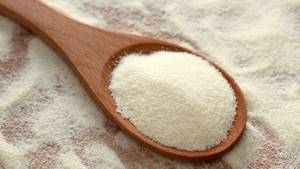
semolina is a typical binding element for any homemade bait
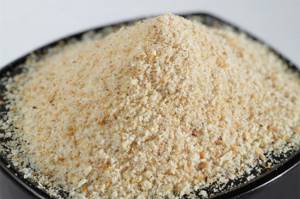
breadcrumbs
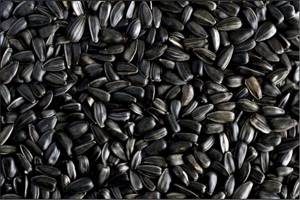
. Bait must correspond to the conditions and habits of the fish. For fish feeding from the bottom, the bait should be scattered along the bottom. But if you are fishing for surface fish, then the bait should crumble on the surface of the water.
Fishing technique and nuances
Fishing for crucian carp in May differs from catching it in the summer. Shy crucian carp not only sees the figure of the fisherman, but also feels the vibrations of the ground under his feet, so it is recommended to catch him while sitting. Having chosen a place, you should carry out several basic fishing techniques:
- Feeding . If feeding is carried out directly on the day of fishing, then it is more correct to do this 30 minutes before the start. For this purpose, bait balls are used, formed from coastal soil and bait, which are thrown to the planned location of the fish. This must be done quietly and carefully approaching the water so as not to spook the fish. Considering that crucian carp prefers to stay in places where the bottom is not very muddy and quite strong, the bait should be fed closer to the bottom.
- Casting Throwing the equipment should be done with smooth pendulum movements. When casting equipment into the intended fishing spot, you should make as little noise as possible.
- Sweeping. If the float begins to make repeating movements up and down, then sharply goes to the side, and after emerging, lies flat on the water, then in this case you should perform a sharp and short hook. You need to carefully prepare for hooking, because if you hurry, the fish will not have time to capture the “prey.” If you delay hooking, the crucian carp will have time to gnaw the hook.
- Fishing. After hooking, the crucian carp becomes very active, but in this case the rush will be unnecessary. It is better to starve a resisting fish and make it tired, and only then can you start fishing. When the crucian carp appears, you need to carefully bring it into the landing net. The most important thing is to prevent the fish from getting the line caught in grass, snags or flooded bushes. When catching small crucian carp, you should carefully lift it from the bottom and “lay” it on its side and pull it to the shore, preventing it from sinking.
Experience has shown that fishing for crucian carp in May has its own characteristics. It differs from summer fishing not only in bait, but also in the choice of location, tactics and feeding of fish. If you take fishing seriously, you can get not only pleasure, but also a good result.
Fishing technique
T
The fishing technique in April is characterized by a constant search for fish. You literally need to sit on the tail of a crucian carp to provoke it to bite. Feed several points at once and fish them one by one. One ball of complementary food the size of a tangerine for each attractive area will be quite enough.
On warm May days, fish begin to accumulate in their usual habitats, feeding intensively before spawning. Choose a suitable place where, in your opinion, the crucian carp is located, and point feed the area where you will cast the fishing rod. To attract fish and keep them on the bait spot, you will need 2-3 balls of bait the size of an average orange. If fishing is carried out on a small pond with a dense concentration of fish, one ball will be enough.
When the bite weakens, from time to time throw up lumps of food the size of a cherry and try to tempt the crucian carp with sandwiches - all sorts of combinations of several baits and attachments. In April, a popular combination is bloodworms + maggots; in May, worms + maggots, a combination of worms with canned corn, and steamed barley grains with maggots have proven themselves to be excellent.
Video on catching crucian carp in spring
Watch catching crucian carp in May using maggots:
Fishing for crucian carp in April using a float rod with bite alarms (bells):
Features of fishing in April
Crucian carp begin to respond to fishing tricks no earlier than mid-April. It makes no sense to try to catch crucian carp in large and deep reservoirs in April. Look for small ponds, swampy spills, drainage ditches of peat bogs and other places where warming water encourages crucian carp to become active.
On April days, fish do not stay long in one area, even the most promising one. The crucian carp bites sluggishly and pokes its nose into the bait for a long time, not daring to take it. The reason is not at all the suspicion of the April crucian carp. The fish have not yet entered into intensive feeding mode, and constant movements are associated not so much with the search for food, but with the need to warm up in cold water.
In April, morning fishing is rarely productive because after a cold night the fish need time to replenish their energy. In April, sometimes the best fishing hours come in the afternoon, when the water warms up to its maximum level.
Features of fishing in May
In May, crucian carp revive almost everywhere, expanding the angler's geography in search of promising places. The fish's appetite flares up, and it becomes easier to tempt it to bite. In warm water, odors spread much better, which gives free rein to the angler’s imagination in preparing bait mixtures and experimenting with baits.
In May, crucian carp do not move around the reservoir much. Occupying their usual areas, crucian carp feed intensively. The fisherman does not need to run along the shore, looking for circles in the water. It is enough to occupy and feed the points that worked last summer.
In May, the crucian carp returns to its typical feeding schedule: morning and evening. This does not mean that you can reel in your gear by lunchtime. Try catching crucian carp in the midday heat. During the pre-spawning period, the fish are hungry, so the daytime bite, although weakened, does not stop. Spawning of crucian carp occurs in the third ten days of May - early June. At this time, switch to catching other fish.
Bait for catching spring crucian carp

As bait for crucian carp, you can use ready-made mixtures or prepared according to your own recipes. The simplest option is chopped worm mixed in clay.
Bait for catching crucian carp in spring - a simple recipe:
- Crumbly boiled millet – 900 g;
- Boiled or steamed pearl barley – 100 g;
- Ground crackers – 500 g;
- Cake and ground sunflower seeds – 300 g;
- Wheat bran – 200 gr;
- Animal components;
- Attractants and flavors.
When fishing for crucian carp in early spring in still very cold water, large fractions in the form of pearl barley and millet are not used. On the contrary, if the crucian carp’s activity is high, more large fractions can be added to the bait in the form of rolled oats flakes, pearl barley, and canned corn.
Mixing bait
You need to mix the boiled and dry ingredients immediately before fishing in the pond. Barley and millet should be quite crumbly, for which they are cooked in a large amount of water.
- First, mix the millet and dry components of the bait until you obtain a mass that forms into balls and gradually crumbles in the water. If the mixture is too dense, add more breadcrumbs and bran.
- Then, boiled pearl barley and animal components are added - chopped worms or maggots - which is also used for bait.
You can add attractants and flavors to the bait, or mix it with ready-made bait from the store that contains these substances. In cold water, fish are wary of odors, so it is important not to overdo it. The smell of cake or seeds should be enough. In addition, you should not use too much bait; in the spring it is better to underfeed the fish.
Tips and secrets
- Crucian carp have very delicate lips, so do not make too sharp hooks, which could result in missing the fish. Hooking with moderate sharpness with a slow action rod will save both the fish and the tackle.
- On cloudy spring days, when fish activity decreases, try seasoning your bait with an accentuated scent. For example, roll the worm in garlic paste prepared ahead of time before attaching it to the hook. In May, and sometimes in April, this method works.
- Cut out a platform in the reeds or reeds and feed it for several days in a row. Shortly before spawning, such plots are catchy even without complementary food, because massive concentrations of crucian carp preparing for the reproductive period are observed precisely in reed thickets.
Place for crucian carp fishing
The depth at which it is necessary to catch crucian carp varies, from 20 cm to 4 m. Large crucian carp are found in places with great depth, in shallow water, because the main thing for crucian carp is warm water and a lot of food. In the spring, fish near the reeds, you can’t go wrong.
Not only attention should be paid to the means of transportation on the water: it is better to fish from a slow-moving inflatable or, in other words, wooden boat, in order to create a noise that scares away fish at the level of a movie theater.
Around the reeds, crucian carp are caught mainly in the spring, and at that time there is a ban on fishing from a boat, therefore special fishing trousers are required. waders (waders). Read more about choosing waders in a separate article. waders for fishing.
